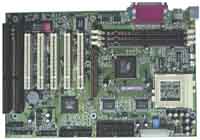For updated information on this motherboard check out our Head to Head comparison that includes this board
Whether we like it or not, the Super7 standard is still around and although it isn't exactly flourishing, as AMD pushes the Athlon the K6-2 and K6-III platforms will need to compete against Intel's "low-end" Celeron and mid-range Pentium III processors if AMD is to survive. From a performance perspective, as we've noticed in our latest Desktop CPU Comparison, the K6-2 and the K6-III have little difficulty competing with their Intel counterparts in most business and some content creation applications, it is in games that they aren't as strong of a force in. However for the user that doesn't play games, AMD is looking to make their once flagship processors the ideal low-cost solution, unfortunately that is where AMD's power stops.
It is up to the motherboard manufacturers to support the standard by producing high quality Super7 motherboards, but it hasn't been until recently that one could arguably call a Super7 motherboard "high quality." Among those motherboards have been recent contributions from companies like Tyan, and more pertinent to the topic at hand, Epox with their MVP3G2.
If you recall, the MVP3G-M from a few months ago was one of the first ideal Super7 motherboards to hit the market. Prior to that release, very few Super7 motherboards were deserving of the processors which they ran, and the introduction of the MVP3G-M changed all that. Now, back with a "new and improved" model, Epox is looking to extend the life of the Super7 platform even more with their MVP3G2, a more robust and tweaked version of the original MVP3G-M. The basic board design is the same and the end product will be quite appetizing even to the most critical of Super7 users, however it isn't perfect. Let's find out why...
| CPU Interface | Super Socket-7 |
| Chipset | VIA MVP3 |
| L2 Cache | 1024KB (512KB/2MB optional) |
| Form Factor | ATX |
| Bus Speeds | 66 / 68 / 75 / 83 / 95 100 / 112 / 124 / 133 |
| Clock Multipliers | 1.5x - 5.5x |
| Voltages Supported | 1.8v - 3.2v (in 0.1v increments) |
| Memory Slots | 3 168pin DIMM Slots |
| Expansion Slots | 1 AGP Slot 5 PCI Slots (1 Full Length) 2 ISA Slots (1 Shared / 2 Full Length) |
| BIOS | Award BIOS 4.51PG |
The Good
"Is a 5/2/1 expansion slot configuration too much to ask for? Absolutely not, although it is a rarity in the Super7 motherboard market, the Epox MVP3G-M starts out with the highly demanded 5/2/1 (PCI/ISA/AGP) layout that many Super7 users have been denied for quite some time."
| Just like the original MVP3G-M, the MVP3G2 (referred to as the G2 from now on) boasts the same 5/2/1 expansion slot configuration (PCI/ISA/AGP) that made the original board such a hit among Super7 users. Of the 8 physical slots (7 usable) only one PCI slot is capable of accepting a full length card. The other four are either blocked by the front panel connectors or the poorly placed floppy drive connector. Conversely, both of the ISA slots are capable of accepting full length cards. |
The three DIMM slots made it over from the original motherboard design and are once again located towards the top end of the motherboard directly behind the ATX I/O panel. Just south of the DIMM slots is the VT82C59MVP North Bridge controller of the MVP3 and slightly to the lower right is the Socket-7 interface connector that gives meaning to the term Super7 motherboard.
The ATX power connector has made a comeback appearance in the same location as it did on the original MVP3G-M, at the bottom edge of the motherboard next to the two IDE connectors. Basically, the G2's layout is nothing more than that of the MVP3G-M, which is a smart move on Epox's part by keeping the cost of producing a new PCB design out of the cost of their motherboard.
The 1MB of on-board L2 (or L3 in the case of a system outfitted with the K6-3) cache is provided courtesy of two 4ns Winbond chips. This is the second time we've seen these 4ns Winbond chips used on a Super7 board, the first was with the Tyan Trinity S1598 we reviewed not too long ago. Also like the Tyan, is the G2's 8ns 32Kx8 Tag RAM module, although Epox chose SBT instead of EliteMT as their preferred manufacturer (no real differences there). The 1MB of L2 cache in addition to the 32Kx8 Tag RAM module cripples the MVP3 chipset's cacheable memory area to 254MB meaning that if any memory is accessed above the 254MB limit, it will result in degraded performance during the accessing of the data stored within that memory space. This, of course, does not apply to K6-3 systems, whose on-chip L2 cache takes care of the cacheable memory area of the system.
The G2 does come with an optional 2MB of L2 cache, that model is specifically renamed as the MVP3G5 and will be plagued by considerably less availability due to the demand for such a product as well as the costs associated with it. Including 512KB of L2 cache on the G2 is an OEM option and although it can decrease the overall cost of the motherboard, the difference won't be great.











0 Comments
View All Comments